



(From top left to bottom right)
Dan "Why Did I Ever Buy Steel Toe-Caps" Miners, Joseph "Merman" Rolfe,
Liam "The Man, The Mission" Missin, Matthew "Best Break-up Story Ever" Donnellan,
Mike "Plunder Yo Booty" Smith, Chris "Sacrifice Him to Our False Gods" Osowski,
Ana "I'm not English" LeMarie, Susan "Where Did That Wave Come From?" Collins,
Victoria "I love Sigma Plot" Venturini, Clare "Evil Carrot" Stratford
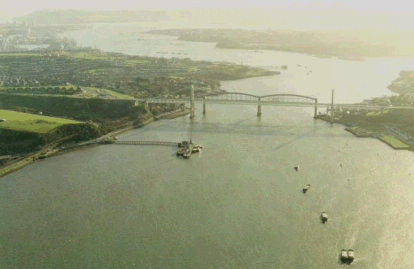
Two parallel tracks (50m separation) between:
|
09:48UTC |
50°19.30N |
004°07.85W |
|
10:20UTC |
50°19.30N |
004°10.00W |
Four parallel tracks (50m separation) between:
|
11:20UTC - 11:48UTC |
50°23.30N |
004°11.77W |
|
50°23.80N |
004°12.56W |
One Van Veen Grab at:
|
|
50°23.659N |
004°12.468W |
Two parallel tracks (50m separation) between:
|
|
50°24.0697N |
004°12.4608W |
|
|
50°25.4787N |
004°12.2668W |
and
|
|
50°25.3479N |
004°12.1762W |
|
13:20UTC |
50°21.8502N |
004°10.2580W |
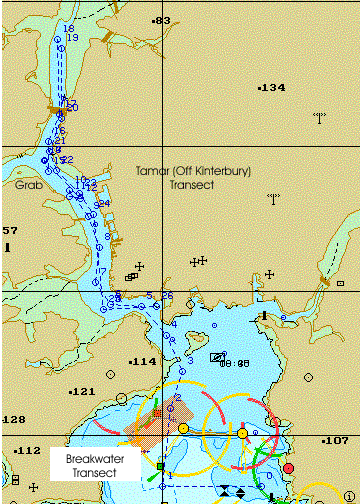
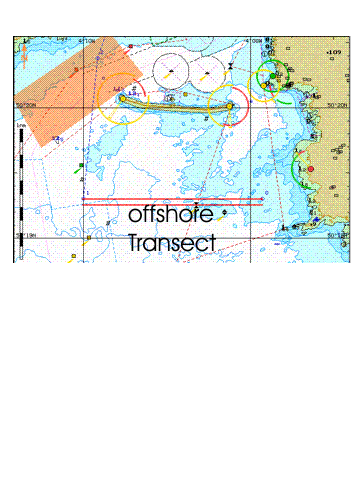
Terrestrial Geology
On the
morning of 24th June 2004 at 0830-1030 UTC, previous to the geophysical survey
of the Plymouth Sound and the Tamar Estuary, the
geological land features of
Preliminary results
Log of
the cliff
Figure 1 - Small Section of Heybrook Cliff (Click to enlarge)
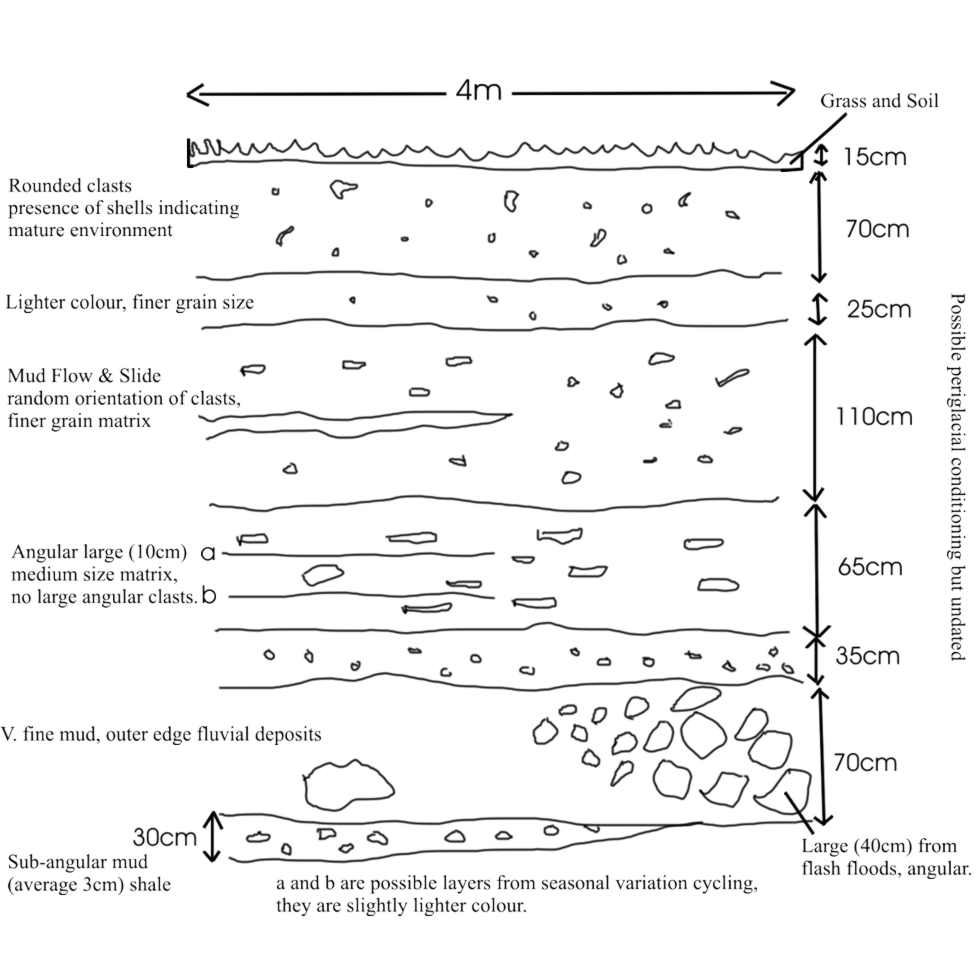 The section studied
(Figure 1) covered an area of
4m wide and 4.2m high. The bottom
section is muddy and characteristic of an outer fluvial environment.
The presence of boulders in this section indicate a high energy environment that
is probably caused by flash floods.
The section studied
(Figure 1) covered an area of
4m wide and 4.2m high. The bottom
section is muddy and characteristic of an outer fluvial environment.
The presence of boulders in this section indicate a high energy environment that
is probably caused by flash floods.
The next section is mainly muddy with
some shale. A section with larger clasts up to 10cm follows indicating a medium
energy environment. Above this section the clast size decreases but the random
orientation of these suggests that they were deposited by mud flows or mud
slides. There are other theories
attributed to the formation of this section, although none have been published. The
random deposits may be associated with the melting of
the ice sheets that covered the north and middle of the
The sequence then moves into a lighter
colour fine grained sediment. The last sequence is characterised by subangular
clasts and many shell fragments. the shells suggests a marine depositional
environment compared to the previous fluvial ones. The angularity of the clasts in most of the cliff indicates their
poor maturity.
Figure
2 - Geological Features of Heywood Bay, South from Shoreline
Dip and strike of beds:
The
beds in this area strike in a SW-NE direction and dip SE with an average inclination of 55°.
Fold:
The outcrop of fold was found at 49240E/48780N. It was identified as a recumbent antiform fold plunging SW with the hinge line pointing 220°.
Fault
A dextral fault cuts through the fold off-setting it by 5 meters. The direction of the fault is 117°. Due to the high tide, further investigation of the fault was not possible.
Side Scan Sonar
Offshore Geology
Figure 3 - Fault Map of Plymouth (Click to enlarge)
The
preliminary objective was to look at the near shore geology off Renney point. A
major fault was found from the side scan sonar and later identified using geology maps (NERC, 1985) (fig.
3) as the Rusey fault.
Figure 4 - Track-plot for the Breakwater Scan

Figure 5 - Bathymetric Profile of Plymouth Sound (Click to enlarge)
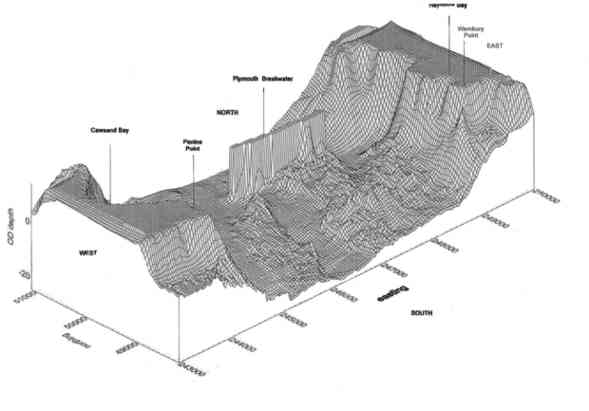 At
246280E the depth of the seabed increased to 19.4m, which corresponded to a
transition of the seabed from rocky outcrop to sediment.
This sediment region extended for 500m and included areas of sand ripples with
wavelengths of ~1m. As the wavelength was relatively small the height of the
ripples could not be determined as the
shadow zone associated with each ripple was not large enough to be measured. The
direction and clear bifurcation of the ripples would suggest that they are wave generated by the storm waves
coming in from the SW. This can be implied because the depth of the area means
that only waves of storm proportions would be able to influence the seabed. Energy rebounded from the breakwater may
also contribute.
Even so, there were small strips of ripples present which could not be wave
generated due to the orientation and lack of bifurcation.
At
246280E the depth of the seabed increased to 19.4m, which corresponded to a
transition of the seabed from rocky outcrop to sediment.
This sediment region extended for 500m and included areas of sand ripples with
wavelengths of ~1m. As the wavelength was relatively small the height of the
ripples could not be determined as the
shadow zone associated with each ripple was not large enough to be measured. The
direction and clear bifurcation of the ripples would suggest that they are wave generated by the storm waves
coming in from the SW. This can be implied because the depth of the area means
that only waves of storm proportions would be able to influence the seabed. Energy rebounded from the breakwater may
also contribute.
Even so, there were small strips of ripples present which could not be wave
generated due to the orientation and lack of bifurcation.
Limitations:
When interpreting the side
scan sonar data a 60 second discrepancy was observed between the two
transects. As they were continuous, this was a 30 second discrepancy on each. It was
determined that this
was due to chronological impairment between the different hardware, namely the
GPS system and the side scan sonar system.
Therefore, the GPS times were
altered by the observed 20 second discrepancy; hence the times on the track
plots are the GPS plus the adjusted time.
River Geology
After examining the offshore area it was decided to head for the upper reaches of the river Tamar. This was for two reasons:
The swell created by the weather of the past few days made most of Plymouth Sound unsuitable for grabs. It was decided that the group should collect a grab sample in order to calibrate the sediment type with the side sonar textures.Previous study of the Plymouth Sound had been performed by other groups so collecting data again from these sites would not yield any new results.
The area of study was the
intersection between the river Tamar and the Lynher
Results:
Figure 6 - Tamar River Plot
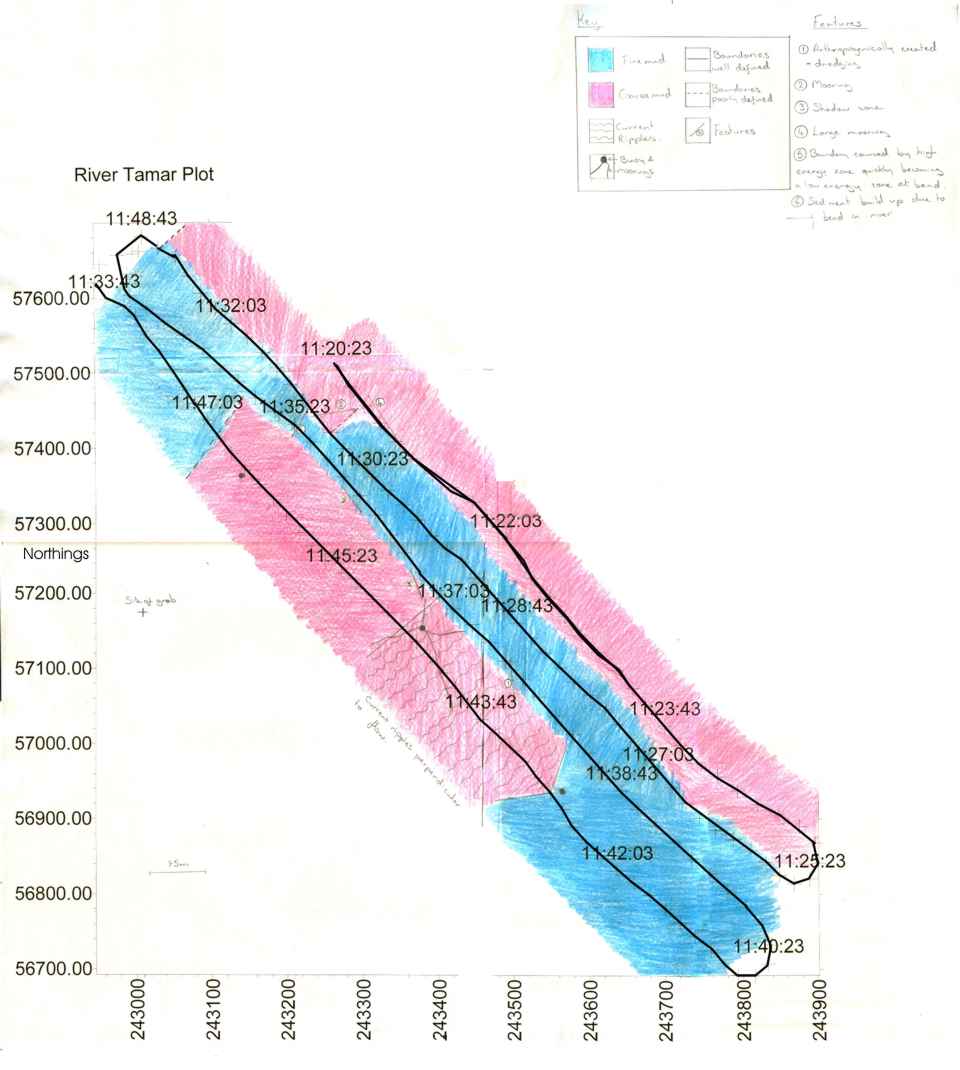 Our
survey of the
area began at 11:20 UTC
Our
survey of the
area began at 11:20 UTC
The complex distribution of sediment grain size can be seen as a result of the two converging rivers along with the flood and ebb of the estuary. The larger grain sizes are as a result of higher energy either from the rivers joining or the bend in the river.
Ripples of a wave length 5.47m between 243500E / 56970N and 243350E / 57160N produced by the currents in the estuary.
Anchor chains which hold the large special buoys in
position can be observed. Using the chains located at 243370E/57160N (
The
Van-Veen grab was used
Composition: Thick, poor quality muddy sediment with a thin anoxic layer
Contains empty Mussel shells, Spartina weed and Polychete worms (about 10cm long). The thin anoxic layer was about 5cm below the surface and had a slight odour.
References:
South
Plymouth Field Course Geophysical Practical Handout.
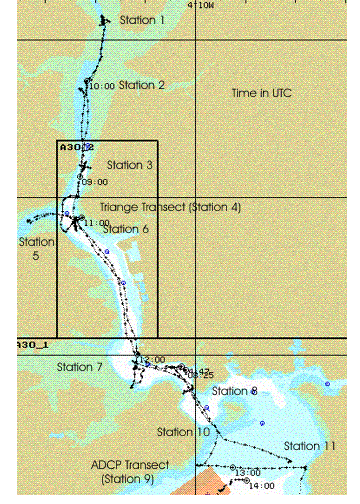
STATION 1:
|
Instrument |
Start |
End |
Files |
||||
|
Time
(UTC) |
Lat. |
Long. |
Time
(UTC) |
Lat. |
Long. |
||
|
ADCP |
|
50°26.191N |
004°11.888W |
|
50°26.246N |
004°11.745W |
6013 |
|
CTD |
|
50°26.263N |
004°11.864W |
- |
- |
- |
G12S1 |
STATION 2:
|
Instrument |
Start |
End |
Files |
||||
|
Time
(UTC) |
Lat. |
Long. |
Time
(UTC) |
Lat. |
Long. |
||
|
ADCP |
|
50°25.368N |
004°12.183W |
|
|
|
6014 |
|
ADCP |
|
50°25.303N |
004°12.182W |
|
50°25.375N |
004°12.332W |
6015 |
STATION 3:
|
Instrument |
Start |
End |
Files |
||||
|
Time
(UTC) |
Lat. |
Long. |
Time
(UTC) |
Lat. |
Long. |
||
|
ADCP |
|
50°24.415N |
004°12.318W |
|
50°24.337N |
004°12.107W |
6016 |
|
CTD |
|
50°24.336N |
004°12.250W |
|
50°24.351N |
004°12.237W |
G12S2 |
|
Instrument |
Start |
End |
Files |
||||
|
Time
(UTC) |
Lat. |
Long. |
Time
(UTC) |
Lat. |
Long. |
||
|
ADCP |
|
50°240.19N |
004°12.334W |
|
50°24.978N |
004°12.632W |
6018 |
|
ADCP |
|
50°24.958N |
004°12.644W |
10:53.58 |
50°24.574N |
004°12.627W |
6019 |
|
ADCP |
|
50°23.576N |
004°12.582W |
|
50°23.754N |
004°12.246W |
6020 |
STATION 5:
|
Instrument |
Start |
End |
Files |
||||
|
Time
(UTC) |
Lat. |
Long. |
Time
(UTC) |
Lat. |
Long. |
||
|
CTD |
|
50°23.714N |
004°13.324W |
|
50°23.699N |
004°13.330W |
G12S3 |
|
Instrument |
Start |
End |
Files |
||||
|
Time
(UTC) |
Lat. |
Long. |
Time
(UTC) |
Lat. |
Long. |
||
|
CTD |
|
50°23.700N |
004°12.410W |
|
|
|
G12S4 |
|
Instrument |
Start |
End |
Files |
||||
|
Time
(UTC) |
Lat. |
Long. |
Time
(UTC) |
Lat. |
Long. |
||
|
ADCP |
|
50°22.038N |
004°11.144W |
|
50°21.587N |
004°11.279W |
6021 |
|
CTD |
|
50°21.823N |
004°11.222W |
|
50°21.829N |
004°11.226W |
G12S5 |
STATION 8:
|
Instrument |
Start |
End |
Files |
||||
|
Time
(UTC) |
Lat. |
Long. |
Time
(UTC) |
Lat. |
Long. |
||
|
ADCP |
|
50°21.598N |
004°10.059W |
|
50°21.515N |
004°10.249W |
6022 |
|
CTD |
|
50°21.546N |
004°10.111W |
|
50°21.577N |
004°10.071W |
G12S6 |
|
Instrument |
Start |
End |
Files |
||||
|
Time
(UTC) |
Lat. |
Long. |
Time
(UTC) |
Lat. |
Long. |
||
|
ADCP |
|
50°20.593N |
004°09.906W |
|
50°20.568N |
004°07.840W |
6023 |
|
Instrument |
Start |
End |
Files |
||||
|
Time
(UTC) |
Lat. |
Long. |
Time
(UTC) |
Lat. |
Long. |
||
|
CTD |
|
50°20.269N |
004°09.518W |
|
50°20.273N |
004°09.498W |
G12S7 |
|
Instrument |
Start |
End |
Files |
||||
|
Time
(UTC) |
Lat. |
Long. |
Time
(UTC) |
Lat. |
Long. |
||
|
CTD |
|
50°20.642N |
004°08.140W |
|
|
|
G12S8 |
Figure 7 - ADCP Figure 8 - CTD
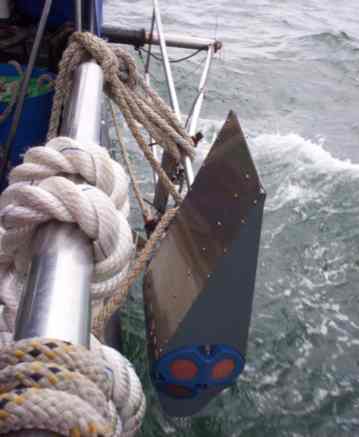
 On the morning of
June 28th 2004, from 0830-1530 UTC, the Research Vessel Bill Conway was used to
sample 11 different stations using a
CTD with Niskin water bottles and ADCP (Fig. 7 and 8).
On the morning of
June 28th 2004, from 0830-1530 UTC, the Research Vessel Bill Conway was used to
sample 11 different stations using a
CTD with Niskin water bottles and ADCP (Fig. 7 and 8).
Previous results from group 6 on June 27th showed a backscatter anomaly (an area of high backscatter) at position 1 (Fig.8). It was decided to investigate this anomaly and carry out three transects around where the anomaly was first seen, in an attempt to explain the position and composition of it. The position of the three transects are shown below in figure 8.
Figure 8 - ADCP sample triangle (Click to enlarge)
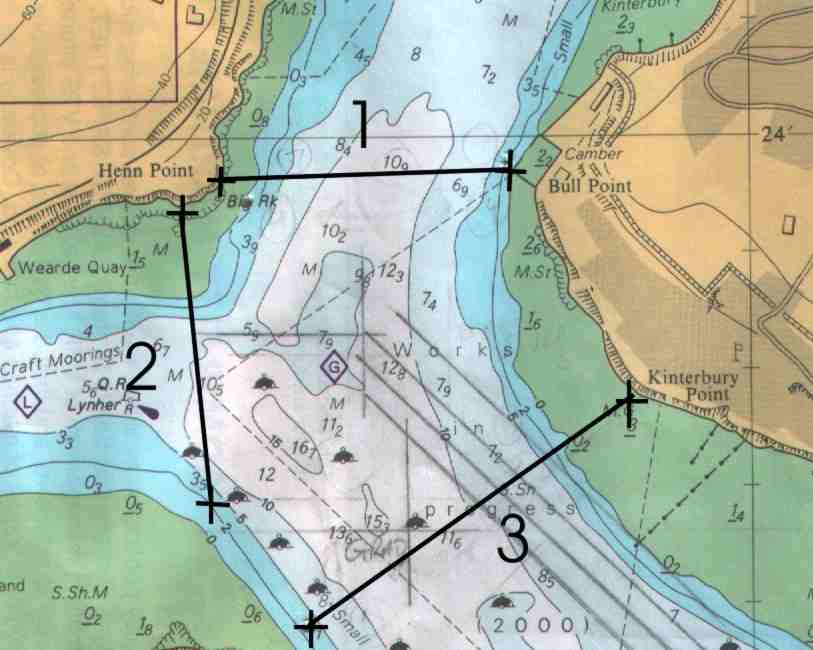 When
the ADCP data was analysed, an
anomaly was seen on the first transect, assumed to be the anomaly observed
the day before. The fluorometer readings were constant, therefore the
backscatter was probably not due to zooplankton but possibly suspended load. It was not seen on the other two transects
suggesting the anomaly was not concerned with the River Lynher or the flow from the mouth of the estuary. Figure 9 shows the anomaly seen at
Position 1.
When
the ADCP data was analysed, an
anomaly was seen on the first transect, assumed to be the anomaly observed
the day before. The fluorometer readings were constant, therefore the
backscatter was probably not due to zooplankton but possibly suspended load. It was not seen on the other two transects
suggesting the anomaly was not concerned with the River Lynher or the flow from the mouth of the estuary. Figure 9 shows the anomaly seen at
Position 1.
Figure 9 - ADCP Backscatter Position 1

The area where the anomaly was seen was scrutinized and it was discovered that a bank extended out from the western shore to the middle of the channel reducing the depth of the channel by five metres, effectively forming a barrier that the current had to move over. It was therefore deduced that the anomaly was due to scouring by the current, increasing the sediment load and hence increasing the backscatter intensity. This is confirmed with the aid of the transmisometer readings (Figure 10).
Normally the program "CTD Analysis" would be used to process these raw data into depth interval averaged, but due to a bug it was unable to analyse certain CTD readings. This can be seen in the station 4 and 5 graphs, as the raw data had to be used, hence the irregular chart lines.
x:\group12\data\Bill Conway (Estuary)\ADCP
x:\group12\processed\Bill Conway (Estuary)\CTD\Excel\alldata(fl).xls
ADCP Profile – Breakwater:
The velocity magnitude profile of the water column, measured by the ADCP, showed a very well mixed water column. There were no major changes to the water column along the track.
The flow direction around the breakwater showed most water flow into the sound coming through the western channel as the direction of flow was to the North East. Direction of flow through the eastern channel is predominantly in a southerly direction, suggesting the flow out of the sound occurs through the eastern channel.
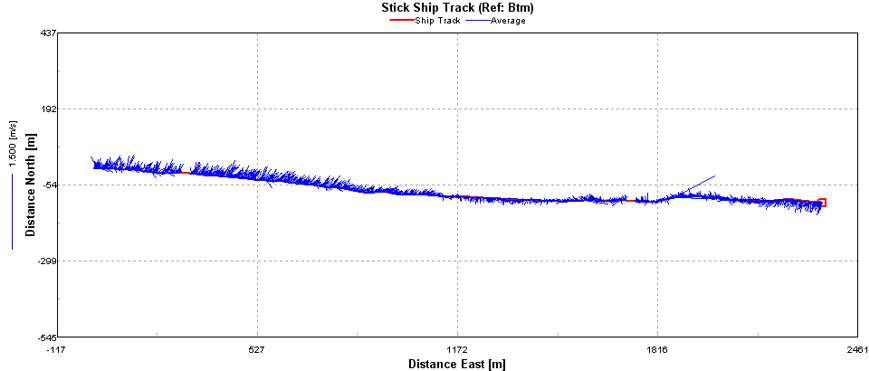
As seen in figure 11 above, flow behind the breakwater also
appears to be southerly. This is due to the breakwater preventing northerly flow
from the open ocean into the estuary. Therefore, the only flow in this
region is from the river outflow in a southerly direction out of the estuary. Even so, flow behind the breakwater is reasonably low.
Silica
Figure 12 (Click top Enlarge)
Figure 12 shows the chlorophyll concentration throughout the estuary. The maximum concentration occurs in the upper estuary , this corresponds to a large reduction in silica concentration in the upper estuary, this drop in silica corresponds with an increase in the amount of diatoms, which utilise silica for test formation.
X:\group12\Data\Processed\Bill Conway (Estuary)\Biology\Chlorophyll\chlorophyll processed.xls
Figure
13 - Salinity vs Silica Concentration
The
mixing diagram shows that silica behaves non-conservatively
with removal occurring between the two end members.
The highest concentration of silica corresponds to the riverine end
member sample. Concentration decreases from 84µmol/l to 28µmol/l over
salinities 0-6, then rises to 36µmol/l at salinity 8 before decreasing to
2µmol/l at the seawater end member. This
removal is assumed to be due to the assimilation of the silica by diatoms.
The
maximum rate of change of silica removal is equal to 8.5µmol/l/psu at a
salinity of circa 6. This is also the salinity where the chlorophyll concentration
and number of diatoms are at a maximum. After this the concentration of
silica decreases to meet the marine end member in a mainly linear fashion.
X:\group12\Data\Processed\Bill Conway (Estuary)\Chemistry\Silica\silicaconway.xls
Figure 14 - Chlorophyll Vs Silica (Click to enlarge)
Figure
14 shows an apparent linear relationship between chlorophyll and silica
concentrations. Chlorophyll increases as silica increases due to the
diatom population requiring silica for cell growth (also being the dominant
species in this situation) and hence being limited in
numbers by the abundance of silica.
X:\group12\Data\Processed\Bill Conway (Estuary)\Chemistry\Silica\silicaconway.xls
Figure 15 - Phytoplankton Concentrations (Click to enlarge)
Figure
15 shows the concentration of phytoplankton through the
estuary. It explains the presence of a chlorophyll spike at a salinity of
6.4, corresponding to a spike of dinoflagellates and diatoms. Diatoms, which have a siliceous cell wall, account for the removal of
silica as shown in Figure 14, which also occurs at a salinity of 6.38.
Cilliate cells remain at a very low level thorough the system only peaking at 2.5 cells/ml
Seawater which is also seen at a salinity of
6.38.
X:\group12\Data\Processed\Bill Conway (Estuary)\Biology\Plankton\zooplankton.xls
Plankton abundance & diversity in the river Tamar and Plymouth Sound
Figure 16 - Plankton Abundances (Click to enlarge)
X:\group12\Data\Processed\Bill Conway (Estuary)\Biology\Plankton\zooplankton.xls
Plankton
trawls were carried out using 200µm mesh size plankton net, both from the RV
Bill Conway.
The
second pie chart shows the species diversity from bottles 1 & 2
carried out at 50°25.480N / 004°12.183W where salinity was 30. Composition of
the Cirripede nauplius species has
dropped to 58% with dinoflagellates composing 23% of all species; the salinity here is higher, conditions are less extreme, and
other groups can compete with the Cirripede
nauplius.
Phosphate
Behaviour along the R. Tamar
Figure 17 - Theoretical Dilution (Click to Enlarge)
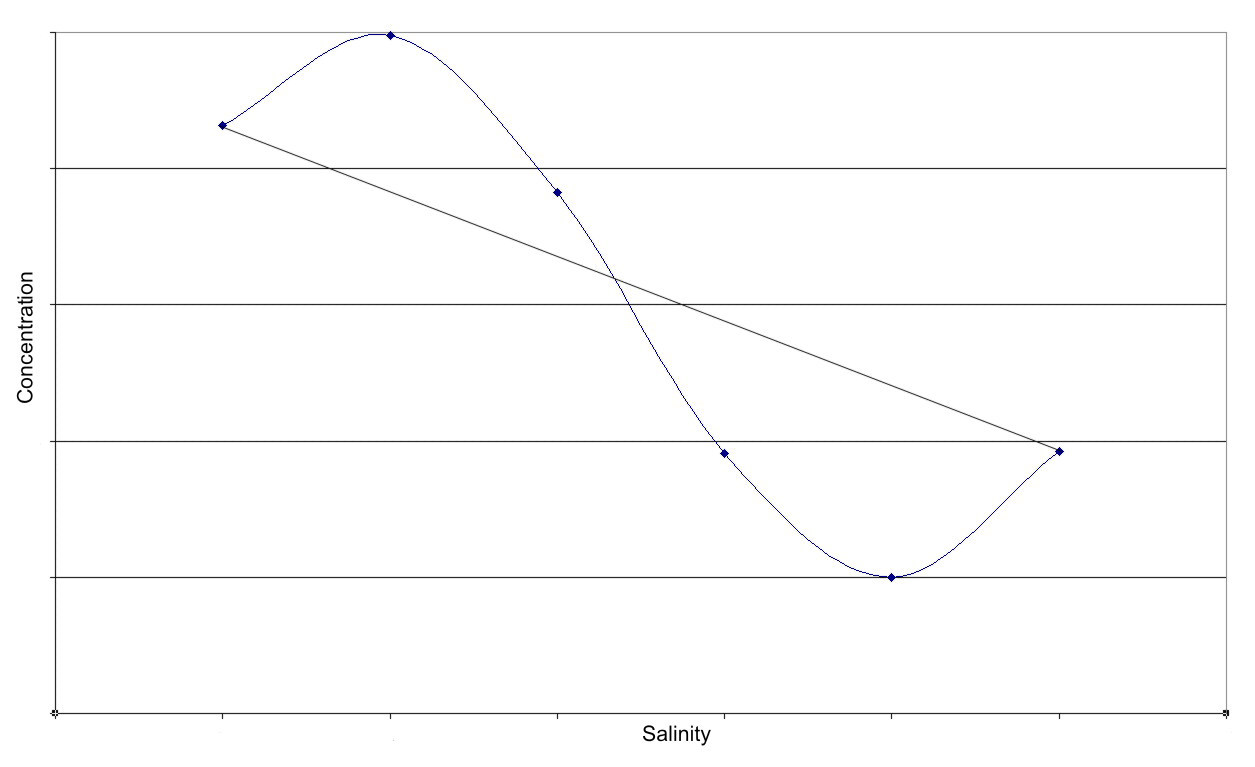 Figure
17 shows the general trend of an addition-removal curve. This trend can be
confirmed by looking at group 1 and 8’s data, found at x:\group1\smallboat\processed
data\group4 data\g4PO4
and x:\group8\billconway\nutrients\phosphate
Figure
17 shows the general trend of an addition-removal curve. This trend can be
confirmed by looking at group 1 and 8’s data, found at x:\group1\smallboat\processed
data\group4 data\g4PO4
and x:\group8\billconway\nutrients\phosphate
Figure 18 - Phosphate against Salinity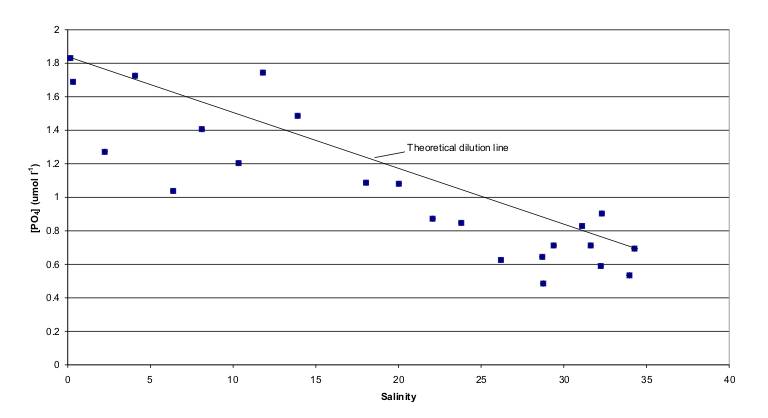 (Click to enlarge)
(Click to enlarge)
At low salinity phosphate concentrations were at a maximum, with a concentration of 1.8µmol l-1. Phosphate is added in the upper estuary, suggesting that phosphate input is from terestial sources. The observed land use in the upper estuary is predominatly farmland, this together with the high rainfall during the sample period may have increased the amount of phosphate being washed of the land. Addition may also be due to inputs from the River Lyhner and the River Tavy
At a salinity of approximately 17, the dominant processes in the estuary is removal, this is probably due to removal in the lower estuary by phytoplankton.
X:\group12\Data\Processed\Bill Conway (Estuary)\Chemistry\Phosphate\phosphate.xls
Figure 19 - Station 11 Phosphate/Salinity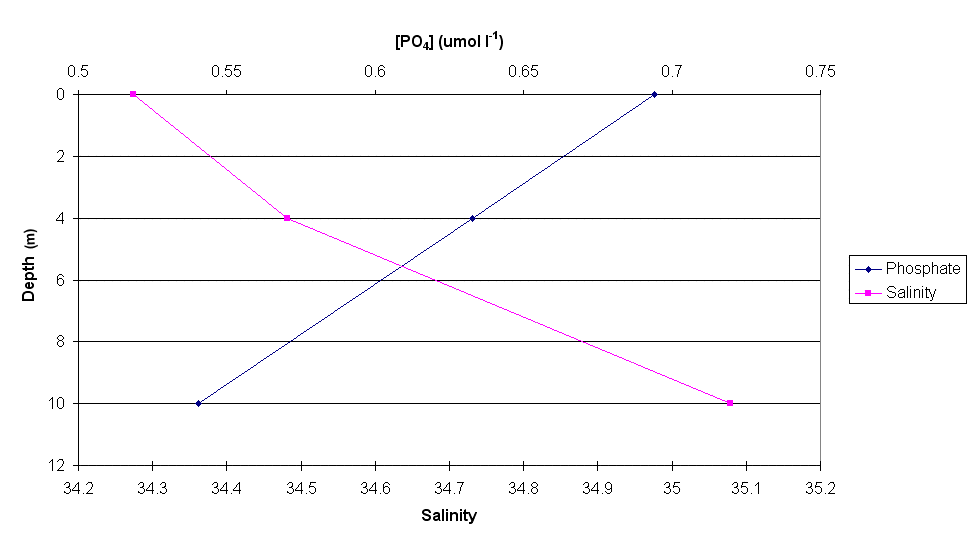 (Click to enlarge)
(Click to enlarge)
To establish the relationship of phosphate and
salinity with depth a vertical profile was plotted for station 11 shown in figure
19. This station was on the eastern side of
Plymouth
Sound at position 50ş 20.642N / 004ş 08.140W. This profile
shows that phosphate decreases with depth whilst salinity increases. The surface
is fresher riverine water, undercut with saline marine water with the same
pattern as the river profile seen in Plymouth Sound - phosphate concentration
decreases with increasing salinity. Depth profiles for other stations appear to
show the same relationship.
Nitrate
Figure 20 - Nitrate against Salinity (Click to enlarge)
As
shown in figure 15, at a salinity of 6.38, a high concentration of
dinoflagellate cells are found. This appears to correspond to the greater
decrease in nitrate at the same salinity, suggesting that the depletion is due
to biological factors. The rate of change is equal to 8.5µmol/l/psu as it was
for the silica.
X:\group12\Data\Processed\Bill Conway (Estuary)\Chemistry\Nitrate\Nitrate.xls
The  The
trip on the Terschelling was taken on
The
trip on the Terschelling was taken on
| Station | Location and Time | Comments |
| 1 | Behind the eastern end of the Breakwater at 50°20.1N / 004°08.4W. 08:20UTC. | Chosen to continue the data series which had been participated in by all bar one previous group. |
| 2 | Cawsand Bay at 50°19.8N / 004°11.2W. 09:10UTC. | Chosen in order to make further observations on the unusual halocline which had been observed by the previous day’s group. |
| 3 | Out of the western end of Plymouth Sound at 50°18.7N / 004°10.2W. 09:52UTC. | Attempting to follow the halocline seen at station 2. |
| 4 | 50°18.5N / 004°07.8W. 10:25UTC. | Following the halocline. |
| 5 | 50°16.9N / 004°07.7W. 10:50UTC. | Chosen in order to obtain offshore data. |
| 6 | Same location as station 2 (50°19.8N / 004°11.3W) but at 12:20UTC. | Chosen in order to see how the situation in the water column had changed temporally since the first station was taken earlier that morning. |
| 7 | Same place as station 1 (50°20.100N / 004°08.300W) but at 12:55UTC. | Chosen in order to see how the situation in the water column had changed temporally since the first station was taken earlier that morning. |
Station 1 and 7
Figure 20 - Station 1 and 7 Silica Concentration (Click to enlarge)
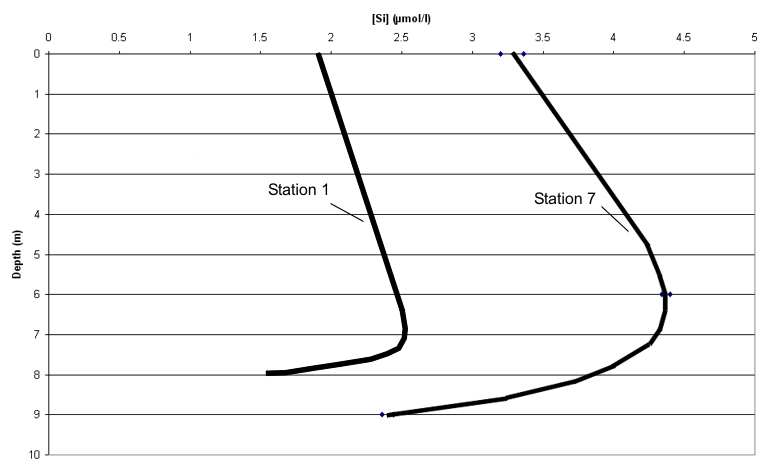 This
was the first site to be sampled at
08:20UTC. It was sampled again at
This
was the first site to be sampled at
08:20UTC. It was sampled again at
X:\group12\Data\Processed\Terschelling (Offshore)\Chemistry\Silica\silica.xls
Subsequently, measurements at station 1 reveal the water is more stratified than at station 7, where values are spread over a larger range. The surface water has a lower salinity than at station 1, and the water at depth has a higher salinity than at station 1.
Figure 21 - Salinity vs Depth at station 1 (Click to enlarge) Figure 21 - Salinity vs Depth at station 7 (Click to enlarge)
X:\group12\Data\Processed\Terschelling (Offshore)\CTD\ctd.xls
Figure 22 - Phosphate and Phytoplankton vs Depth at station 1 (Click to enlarge)
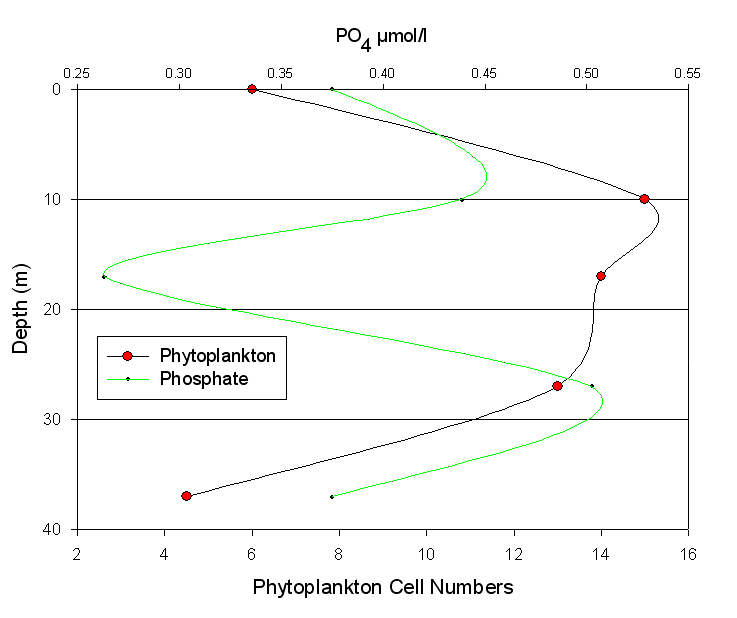 At
the surface, phosphate concentration is double compared to station 7. Chlorophyll
concentration graphs for each station help account for these values of
phosphate. For station 1 phosphate
decreases from the surface down to a depth of 7m while chlorophyll concentration
increases. At 10m phosphate starts
to increases and chlorophyll decreases slightly
after 7m. At station 7, phosphate
concentration increases from 0.25µmol/l at the surface to almost 0.3µmol/l at
6m, from which point it continues to increase at a greater rate until 9m where
it reaches 0.37µmol/l. When
compared to chlorophyll the
inverse relationship is present again. This could be due to the lower concentration of phosphate at this site
partially limiting the phytoplankton population, thus lowering chlorophyll
concentration. In the surface layer chlorophyll concentration decreases
slightly down to a depth of 6m, due to this
apparent decline of phytoplankton, phosphate concentrations increases over this
depth. After which, chlorophyll
concentration decreases at a greater rate and phosphate increases as moving further away from the surface, and deeper into the euphotic
zone.
At
the surface, phosphate concentration is double compared to station 7. Chlorophyll
concentration graphs for each station help account for these values of
phosphate. For station 1 phosphate
decreases from the surface down to a depth of 7m while chlorophyll concentration
increases. At 10m phosphate starts
to increases and chlorophyll decreases slightly
after 7m. At station 7, phosphate
concentration increases from 0.25µmol/l at the surface to almost 0.3µmol/l at
6m, from which point it continues to increase at a greater rate until 9m where
it reaches 0.37µmol/l. When
compared to chlorophyll the
inverse relationship is present again. This could be due to the lower concentration of phosphate at this site
partially limiting the phytoplankton population, thus lowering chlorophyll
concentration. In the surface layer chlorophyll concentration decreases
slightly down to a depth of 6m, due to this
apparent decline of phytoplankton, phosphate concentrations increases over this
depth. After which, chlorophyll
concentration decreases at a greater rate and phosphate increases as moving further away from the surface, and deeper into the euphotic
zone.
X:\group12\Data\Processed\Terschelling (Offshore)\Chemistry\Phosphate\phyt PO4.jnb
Figure 23 - Nitrate verses Depth for Stations 1 and 7
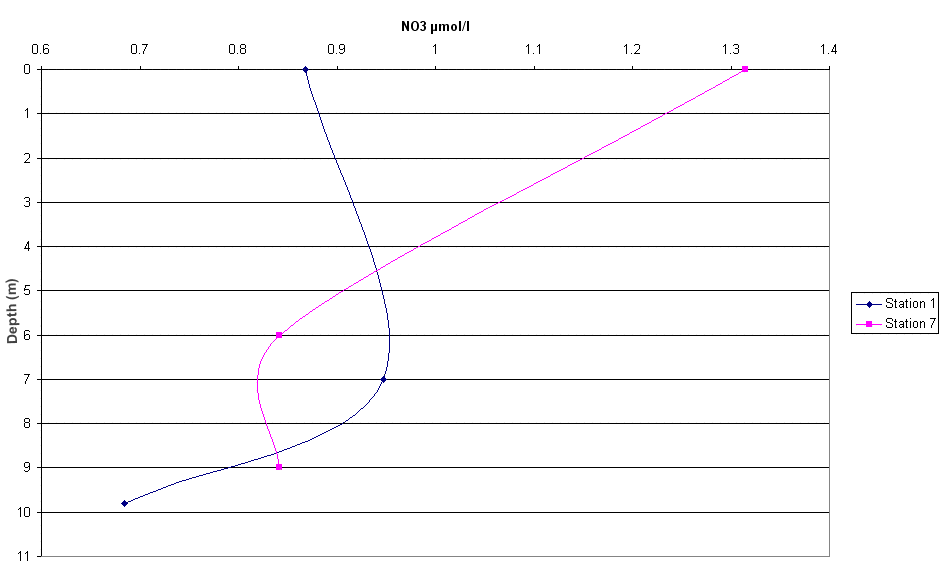 Nitrate
concentration at station 1 is overall lower than the values found at station 7.
This can be linked back to the salinity graphs for these stations which
show station 1 as having fairly good stratification and station 7 as having less
saline surface waters and greater salinity of deeper waters in comparison to
station 1, thus there is more fresh water at station 7 which would account for
the higher readings of nitrate. At
station 1 nitrate concentration increases from the surface to 8m, where after it
decreases at a greater rate to the depth of 10m.
The nitrate concentration over depth for station 7 decreases rapidly to
6m, then decreases at a much lower rate to 9m.
These variations could be attributable to extent of mixing of water
column, as the expected inverse relationship between chlorophyll and nitrate is
not apparent. This may be due to a
lack of data points giving an incomplete overview.
Nitrate
concentration at station 1 is overall lower than the values found at station 7.
This can be linked back to the salinity graphs for these stations which
show station 1 as having fairly good stratification and station 7 as having less
saline surface waters and greater salinity of deeper waters in comparison to
station 1, thus there is more fresh water at station 7 which would account for
the higher readings of nitrate. At
station 1 nitrate concentration increases from the surface to 8m, where after it
decreases at a greater rate to the depth of 10m.
The nitrate concentration over depth for station 7 decreases rapidly to
6m, then decreases at a much lower rate to 9m.
These variations could be attributable to extent of mixing of water
column, as the expected inverse relationship between chlorophyll and nitrate is
not apparent. This may be due to a
lack of data points giving an incomplete overview.
Some of the data for station 1, including our phytoplankton
data was,
unfortunately, lost.
X:\group12\Data\Processed\Terschelling (Offshore)\Chemistry\Nitrate\nitrate tech.jnb
Station 2
Station
2 (50°19.792 N, 004°11.334 W) was studied at
Figure 24 - Thermocline Station 2
Station
2 had a depth 12m and a current of ~ 0.8knts with a flow direction of 225°.
Cawsands bay is sheltered by a headland meaning that the winds which were
X:\group12\Data\Processed\Terschelling (Offshore)\CTD\Excel\allstats.xls
Figure 25 - Silica Station 2
Nitrate
shows no change through the top 5m recorded (unknown below this depth as data was
lost due to an accident in the lab). The nitrate reading remains constant at
roughly 0.6 μM. Silicate increases linearly by roughly 0.25 μM over the 5m depth recorded.
Phosphate decreases through the top 5m from 0.45 μM to 0.175 μM and
Chlorophyll decreases from 1.75 μg/l to 1.5 μg/l from surface to 5m, then
increases to 2.1 μg/l at 10m.
X:\group12\Data\Processed\Terschelling (Offshore)\Chemistry\Silica\Silica.xls
Figure 26 - Phytoplankton Station 2
Phytoplankton increases from 22 cells per ml of seawater to 35 cells per ml of seawater over the first 4m then decreases to ~10 cells per ml of seawater at 10m.
The following describes the physical data obtained from the station.
ADCP: there is a noticeable high backscatter at ~ 5m
CTD: This shows a distinct thermocline at 5.7m
Discussion
Due to the loss of results it is thought that the chemical data may contain substantial errors. The following discusses the above results with respect to each other and tries to put forward some initial ideas as to how they are linked.
The phytoplankton maximum is found in the top 5m of the water column and is believed to be constrained by the thermocline.
Phytoplankton uses nutrients suggesting that the nutrients should decrease with increasing phytoplankton.
What was actually seen is:
|
Phosphate decreases. |
|
|
Nitrate remains same |
|
|
Silicate increases only slightly. (could be put down to human error). |
Chlorophyll concentration, which is positively proportional to phytoplankton, appears to be negatively proportional at this station. This requires further investigation but is believed to be error created by the following possible errors.
Station
3
Figure 27 - Nitrate Station 3
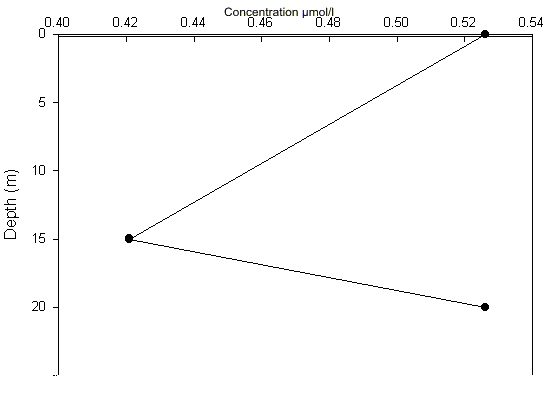 At
station 3 the CTD was deployed at 50°18.696N / 004°10.237W and showed the presence of a thermocline and halocline at the depth
of 10m.
At
station 3 the CTD was deployed at 50°18.696N / 004°10.237W and showed the presence of a thermocline and halocline at the depth
of 10m.
Figure 27 and 28 show how phosphate and nitrate increase from a depth of 15m.
Silica increases from a depth of 10m. But it is not possible to know what silica is doing at depth shallower than 10m due to data loss.
X:\group12\Data\Processed\Terschelling (Offshore)\Chemistry\Nitrate\nitrate tech.jnb
Figure 28 - Phosphate Station 3
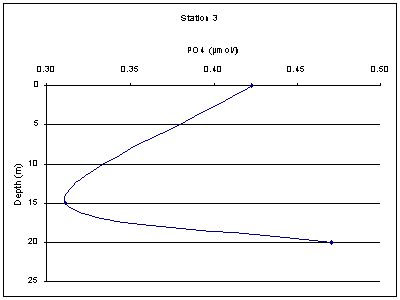
X:\group12\Data\Processed\Terschelling (Offshore)\Chemistry\Phosphate\Phosphate.xls
Figure 29 - Chlorophyll Station 3
Chlorophyll
concentration starts decreasing at 10m and at 15m it undergoes a rapid decline
in concentration (Fig. 29). This decrease in chlorophyll and increase in nutrient
concentration corresponds to the thermocline depth that does not allow mixing
between the upper and lower layer.
Another limiting factor for the growth of phytoplankton at this station is light irradiance, the 1% light depth was measured at 21m from the 7m secchi disc depth.
X:\group12\Data\Processed\Terschelling (Offshore)\Biology\Chlorophyll\chl graph.doc
Station 5.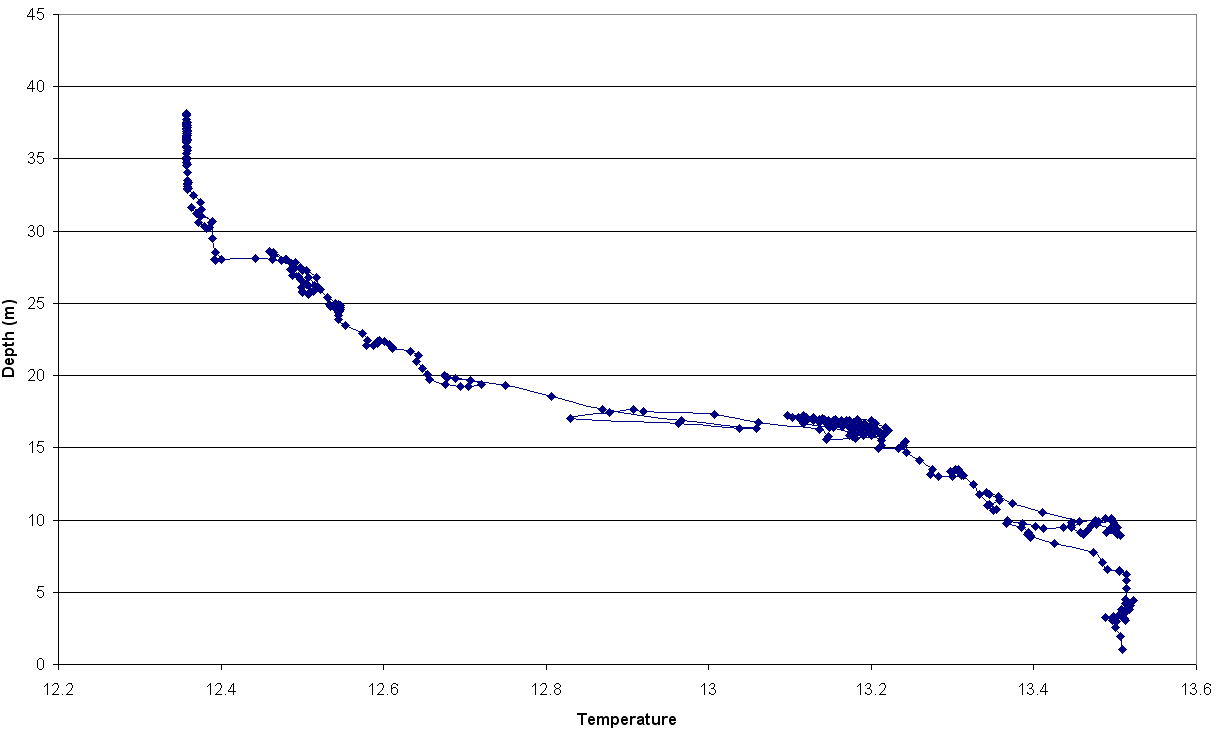 Figure 30 - Thermocline Station 5
Figure 30 - Thermocline Station 5
Station 5 was offshore at 50°18.5N/4°07.7W, 1050UTC.
Station five shows a well stratified water column. By using CTD data, a strong thermocline can be seen at 15m with a change in temperature from 13.5°C to 12.4°C. The secchi depth of 8m allows us to calculate the depth of the euphotic zone as 24m. Water above the euphotic zone has a temperature of 13.5°C and salinity of 35.16 while below its 12.5°C and 35.25.
X:\group12\Data\Processed\Terschelling (Offshore)\CTD\Excel\allstats.xls
Figure 31 - Phytoplankton Station 5
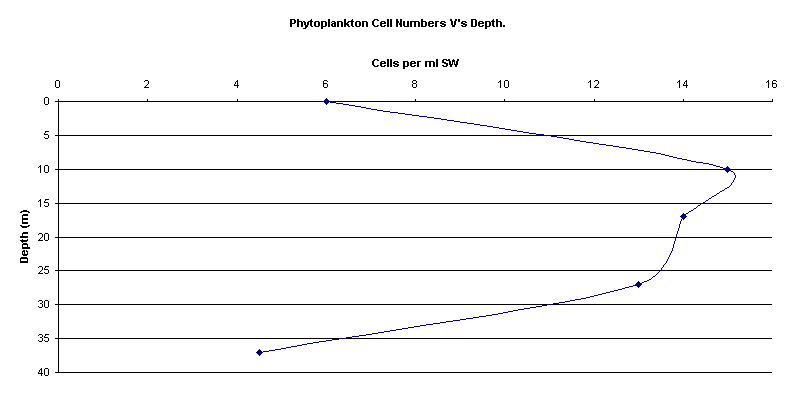 Due to euphotic stratified waters being exhausted of inorganic nutrients during
the summer months (Kiorbe 1993) phytoplankton levels are at their maximum
(15cells/ml SW) at, or near the thermocline due to nutrient recycling below.
This can be seen clearly on the plots of phytoplankton numbers. Looking at the various data sets for the nutrients
analysed at this station a clear
pattern is seen which backs this up. The phosphate, nitrate and silica
concentrations show an inverse relationship with cell numbers, where an increase
in phytoplankton numbers sees a reduction in these nutrients.
Due to euphotic stratified waters being exhausted of inorganic nutrients during
the summer months (Kiorbe 1993) phytoplankton levels are at their maximum
(15cells/ml SW) at, or near the thermocline due to nutrient recycling below.
This can be seen clearly on the plots of phytoplankton numbers. Looking at the various data sets for the nutrients
analysed at this station a clear
pattern is seen which backs this up. The phosphate, nitrate and silica
concentrations show an inverse relationship with cell numbers, where an increase
in phytoplankton numbers sees a reduction in these nutrients.
X:\group12\Data\Processed\Terschelling (Offshore)\Biology\Plankton\phytoplankton.xls
Figure 32 - Nitrate Station 5
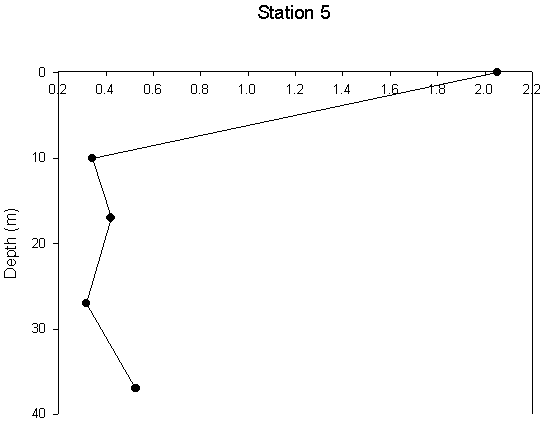 Looking in more detail at phosphate and silica, a
sub-maxima is seen at 10m
which coincides with the phytoplankton maxima. The high presence of
phytoplankton causes a decrease in silicate and phosphate due to consumption. As
the nutrient levels become limiting ca.17m the phytoplankton levels also drop,
so by 20m there are 13 cells/ml SW. These
data show a spike in both silica and phosphate levels at 10m, the exact reason
for this isn’t clear as it would be expected to see a decrease in the levels. The
two explanations for this is either that it is an error as the peaks do
fit within the error margin set by the error bars, or that the phytoplankton had
only recently arrived in the area. However this would require further
investigation.
Looking in more detail at phosphate and silica, a
sub-maxima is seen at 10m
which coincides with the phytoplankton maxima. The high presence of
phytoplankton causes a decrease in silicate and phosphate due to consumption. As
the nutrient levels become limiting ca.17m the phytoplankton levels also drop,
so by 20m there are 13 cells/ml SW. These
data show a spike in both silica and phosphate levels at 10m, the exact reason
for this isn’t clear as it would be expected to see a decrease in the levels. The
two explanations for this is either that it is an error as the peaks do
fit within the error margin set by the error bars, or that the phytoplankton had
only recently arrived in the area. However this would require further
investigation.
X:\group12\Data\Processed\Terschelling (Offshore)\Chemistry\Nitrate\nitrate tech.jnb
Figure 33 - Phosphate Station 5
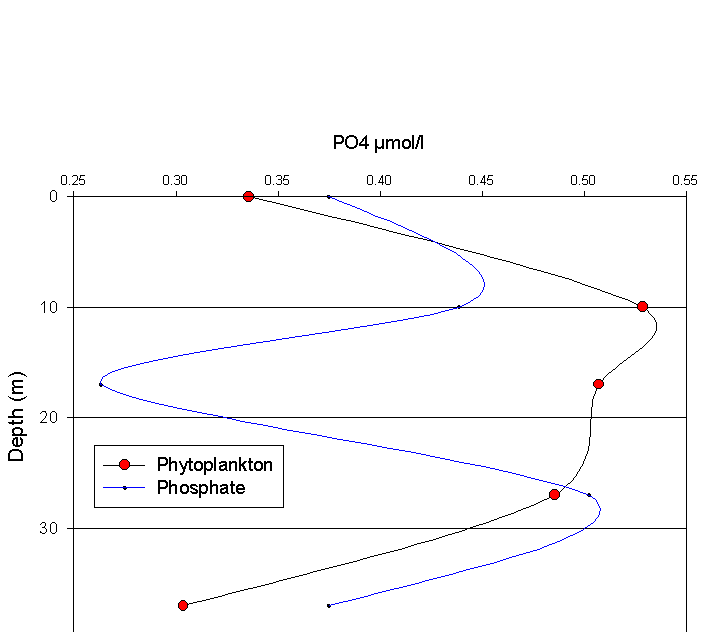 This results in a decrease in consumption of nutrients which
combined with the
rich waters below the thermocline allows the nutrient levels to rise suddenly,
this produces a PO4 maximum at 30m of 0.50µmol/l-1. Due to the low irradiance
(24m euphotic layer base) the phytoplankton at this depth are unable to reform
and utilize the nutrients. So light is a limiting factor.
This results in a decrease in consumption of nutrients which
combined with the
rich waters below the thermocline allows the nutrient levels to rise suddenly,
this produces a PO4 maximum at 30m of 0.50µmol/l-1. Due to the low irradiance
(24m euphotic layer base) the phytoplankton at this depth are unable to reform
and utilize the nutrients. So light is a limiting factor.
X:\group12\Data\Processed\Terschelling (Offshore)\Chemistry\Phosphate\Phosphate.xls
Station
6
Station 6 (50°19.819 N, 004°11.387 W) at 11:51 UTC had a depth 12m and a current of ~ 0.1 (slack) with a flow direction of 190°. Cawsands Bay is sheltered by a headland meaning that the winds, which were South Westerly, gusting 20knts out to sea, were not present and the area was relatively calm. The following describes the results obtained from chemical sampling
Phytoplankton decreases linearly from 17.5 to 6.2 cells per ml of seawater from surface to 8m.
The following describes the physical data obtained from the station.
A
major point to be analysed is why is the thermocline more pronounced at
At
CTD profiles – Station 2, 3 and 4
When
Station 2,
Figure 34 - Station 2, 3, and 4 Salinity Profile
X:\group12\Data\Processed\Terschelling (Offshore)\CTD\Excel\CTD.xls
The
halocline was still present at Station 3 yet less pronounced.
Once again shown in figure 34, the halocline was even less pronounced at
Station 5. A possible reason for
this is that the fresh water present inshore is being held into
Figure 35 - Station 2, 3, and 5 Temp Profile
Figure 35 (above) shows the thermocline present at the three stations. Once again the thermocline reduces in depth as it approaches the shore. The thermocline is consistently present in all stations, suggesting that the seasonal thermocline is in its genesis. The surface temperatures of Station 2 and 3 are higher than Station 5, demonstrating the presence of fresher water emanating from the estuary
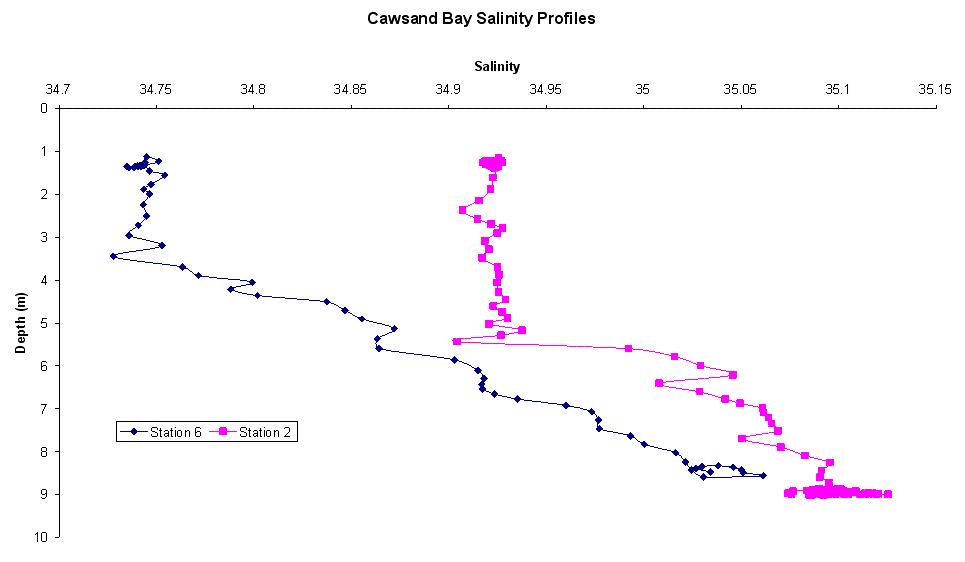
X:\group12\Data\Processed\Terschelling
(Offshore)\CTD\Excel\CTD.xls
Figure
36 shows the temporal variation in the halocline, at
Using
the data worked-up by group 9 the following can be inferred:
In the mixing diagram, non-conservative behaviour due to removal is exhibited by phosphate. The rate of removal (0.103µmol/l/psu) is greatest over salinities 8 to 16. Contrary to the results from the samples taken on the 28/06/2004 from the RV Bill Conway, no additional phosphate was observed from the RIB data on the 5/07/2004. This may be due to the lack of rain proceeding the 5th of July that was present before the 28th of June and would have added extra phosphate to the surface runoff from surrounding farmland.
x:\group12\data\processed\Ribs (Estuary)\Chemistry\Phosphate\Phosphate.xls
Figure 38 (Click to Enlarge)
x:\group12\data\processed\Ribs (Estuary)\Chemistry\Phosphate\Phosphate.xls
Non-conservative
behaviour due to slight addition is exhibited by nitrate at a constant rate.
The excess nitrate could be attributed to
surface runoff from farmland, or from nearby sewage and industrial waste from the
site and sewage works at
Figure 39 (Click to Enlarge)
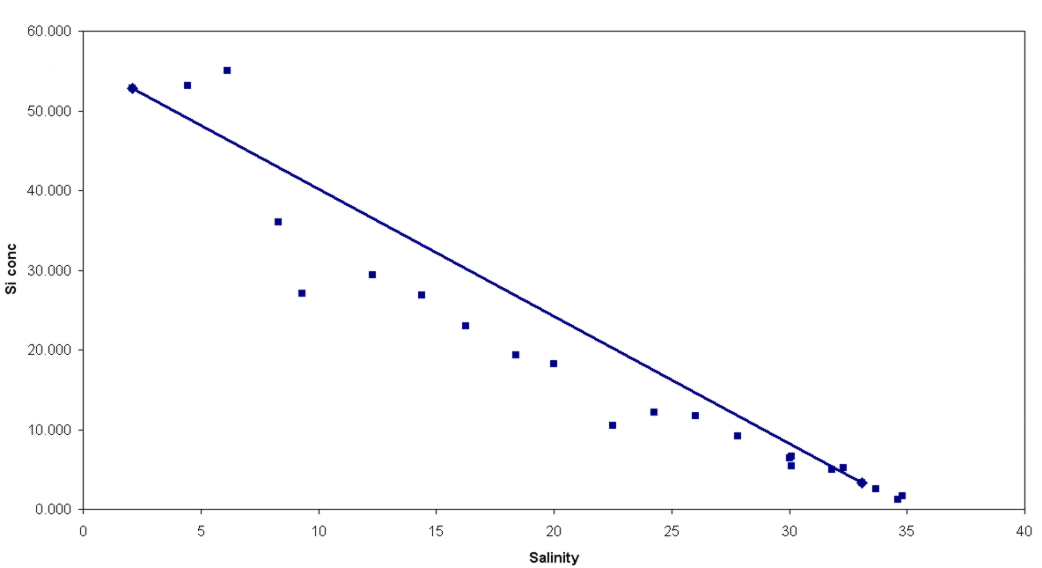
x:\group12\data\processed\Ribs (Estuary)\Chemistry\Phosphate\Phosphate.xls
The source of dissolved silica is the erosion of terrestrial rocks
Non-conservative removal occurs for silica, except for salinities 4-6, where
addition appears to be occurring, however these two points could be anomalies
caused by human error. The rate of removal is greatest at salinities 8-9 with a
value of 9µmol/l/psu. This correlates with the high chlorophyll values found at
this station: the highest chlorophyll concentration found was 53µg/l at a
salinity of 5, whilst the lowest concentration found at a salinity of 30 was 9µg/l.
The silica is assimilated by diatoms, identified during analysis of
phytoplankton samples, where diatoms were found the dominant species. This has
been seen before in
Previous
groups (2, (X:\group2\Data\Estuary Bill Conway\Processed
data\Graphs\Silica Concentration against salinity.JNB, 1 (X:\group1\smallboat\processeddata\Phosphate
data 2.JNB) also show this “phytoplankton bloom” and chemical
implications at different salinity readings. It is the belief of group 12 that
the phytoplankton bloom, diatoms which cannot swim against the current) is being
gradually moved down the river by tidal flushing hence we find the chlorophyll
spike and silica spike at increasing salinities through out the course
of the two weeks (24/06/04ŕ
07/07/04)
Zooplankton
|
Trawl |
Salinity |
Time
(UTC) |
Lat
(N) |
Long
(W) |
Time
of trawl (mins) |
|
Tamar
|
30 |
1307 |
50° 24.403 |
4° 12.250 |
4 |
|
Breakwater |
34.5 |
0950 |
50° 19.983 |
4° 08.028 |
3 |
|
Lynher |
30.1 |
1250 |
50° 23.798 |
4° 12.943 |
4 |
|
Station
1 |
10 |
1121 |
50° 25.120 |
4° 13.121 |
4 |
|
Station
2 |
20 |
1218 |
50° 27.564 |
4° 12.586 |
4 |
|
Station
3 |
16 |
1148 |
50° 27.542 |
4° 13.531 |
4 |
Mesh size of the net
was 200µm and had an opening area of 0.196m2.
Station 1 was
dominated by Copepods and Mysids with nothing else found in the trawl. Station 2
and 3 showed the same species composition, with very few species although the
two species that were found were high in numbers. At the Tamar bridge trawl
other species became more abundant. The low diversity at lower salinity may be
due to the riverine environment being a reasonably high energy, not suitable for
less versatile species. Copepods and Mysids are known to be versatile, therefore
can survive in the stressful environment of the river. By the
Figure 40 - Tamar Bridge Zooplankton
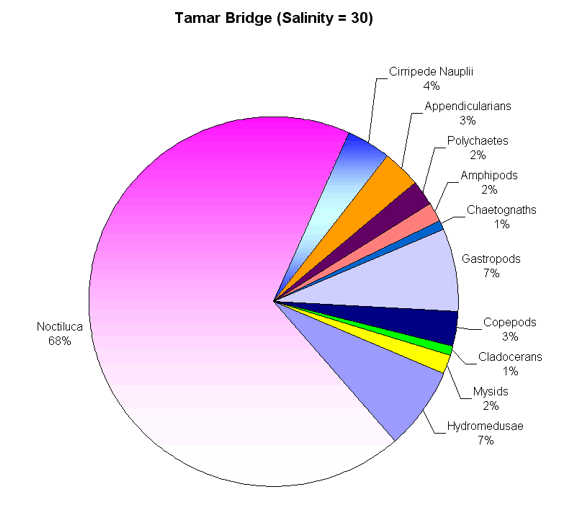 The
The
x:\group12\data\processed\Ribs(Estuary)\biology\phytoplankton\phytopl.xls
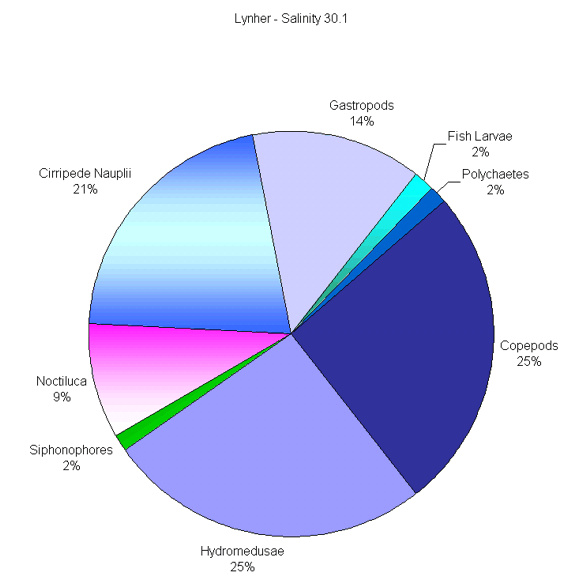 The Lynher trawl (Figure
41), near the Lynher River confluence, showed copepods (25%) and Hydromedusae (25%) to be the
most dominant species. This could account for the relative decrease of the
dinoflagellate Noctiluca scintillans
present in the previous sample. The increase of copepods and hydromedusae
around the Lynher input may suggest high concentration of these species in the
Lynher, although could also be attributed to increasing distance down river,
however, the Lynher station was only 100-200m further down river, which
wouldn’t affect conditions too greatly. The increase could also be due to an
increase in nutrients preferable to these species. Cirripede Nauplii (21%), was
the second most abundant group.
The Lynher trawl (Figure
41), near the Lynher River confluence, showed copepods (25%) and Hydromedusae (25%) to be the
most dominant species. This could account for the relative decrease of the
dinoflagellate Noctiluca scintillans
present in the previous sample. The increase of copepods and hydromedusae
around the Lynher input may suggest high concentration of these species in the
Lynher, although could also be attributed to increasing distance down river,
however, the Lynher station was only 100-200m further down river, which
wouldn’t affect conditions too greatly. The increase could also be due to an
increase in nutrients preferable to these species. Cirripede Nauplii (21%), was
the second most abundant group.
Figure - 42 Breakwater Zooplankton
 The breakwater trawl
was taken just east of the breakwater. The main zooplankton identified were
Copepods (72%) (Figure
42),
which suggest they prefer more saline conditions although can survive at lower
salinities. Hydromedusae (10%) were the second most dominant species. The
previous abundance of Noctiluca sp. had decreased to only 3%, which may suggest the
species prefer less saline conditions or simply that grazing by Copepods has
decreased numbers. (Fock and Greve, 2002). The abundance of Copepods suggests
they out compete most other species for nutrients and food in this region.
The breakwater trawl
was taken just east of the breakwater. The main zooplankton identified were
Copepods (72%) (Figure
42),
which suggest they prefer more saline conditions although can survive at lower
salinities. Hydromedusae (10%) were the second most dominant species. The
previous abundance of Noctiluca sp. had decreased to only 3%, which may suggest the
species prefer less saline conditions or simply that grazing by Copepods has
decreased numbers. (Fock and Greve, 2002). The abundance of Copepods suggests
they out compete most other species for nutrients and food in this region.
Comparing these data
with the zooplankton counts from the RV Bill Conway and Ribs taken on 28th
June 2004 shows that copepods dominate the more saline water off the breakwater,
however, the presence of Noctiluca found in the less saline river environments
was not seen on the 28th June. The dominant species in these samples
were Cirripede Nauplii, which was present on the 5th July, in much
lower numbers. There were, however, dinoflagellates present which may have
included Noctiluca scintillans. Hydromedusae were present in much higher
concentrations on the 5th July than the 28th June; this
may suggest a bloom in this species or the movement of a community from the
Lynher into the Tamar. Overall, the species do not change greatly between the
two days at the positions sampled. Refer to the Bill Conway figures for more
detailed comparison.